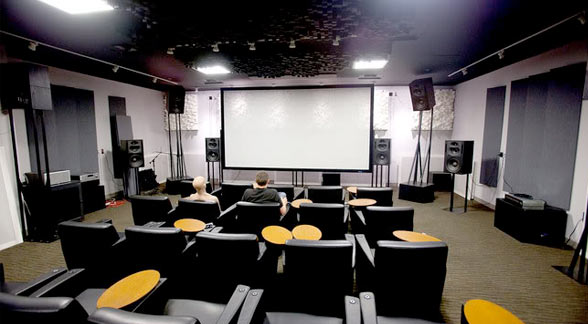More Speakers…Better Experience?
Listening to music mixed in 5.1 surround is as different from listening in 2.0 channel stereo as 3D Ultra HD-Video is from B&W standard television. I’ve been a strong advocate for 5.1 immersive music mixing for over a decade and cannot imagine going back to straight stereo.
My attorney and his son (my new intern for a couple of weeks) came by the studio yesterday and I treated them to a short demonstration in my main playback room. I played half dozen tracks from our HD-Audio Sampler 2013 disc to give them an idea of what AIX Records does. The new sampler is the perfect disc to use because it has over 40 different tracks, it includes HD-Video of each track AND there are three separate mixes that can be accessed for each track. This is the ultimate “have it your way” demo disc.
During these demos I always start with the most aggressive or “stage” perspective 5.1 surround mix. A “stage” mix places you in the middle of the sound. Well, it’s not really the middle because a properly configured ITU 5.1 surround setup is front loaded…there’s three speakers up front and only two providing the surround aspect of a mix. And the two are only 110-120 degrees off of the centerline. They are NOT as show in Robert Harley’s book on High-End audio behind the listener.
As a general rule, I do not allocate a lot of sound to the center speaker because I never really know if it is a capable as the left and right front speakers. So I use what’s called “Phantom Center” imaging instead. To get a sound such as the lead instrument or vocal to come from the center of a stereo pair of speaker, the mixer will distribute the signal equally to the left and right resulting in a center image. (NOTE: The amount of energy sent to the left and right speakers is diminished by 3 dB because there are now two speakers producing the sound…this center attenuation is typically engineering into the panning circuits of a console.).
Once the demo has been going for a little while and the participants have gotten used to hearing sound coming from all directions, I hit the AUDIO button on the remote and switch to the 2.0 channel stereo mix. The listener’s reactions are universally the same. “What happened? The sound is so narrow and small sounding!” they report. I explain that traditional stereo was a major step forward from the previous monophonic HiFi generation but 5.1 surround (or even more) enhances the experience yet again.
Of course, there are different approaches to mixing in surround. Labels that are putting out surround recordings include a single surround mix and usually have a stereo mix as well. It is rare for the 2.0-channel mix to be a “downmix” of the 5.1 surround mix, although DTS-HD and Dolby TrueHD include coefficients for downmixing (more on that in another post). Mixing in 5.1 surround or even more channels (11.2 or 22.4!) doesn’t have the history that stereo does but engineers are starting to understand the format. AND consumers are getting plenty of experience with surround sound in movie and home theaters. It’s only a short leap to getting surround music on a regular basis. I talked about how to get surround in your car in a previous post. Tomorrow, I’ll clue you in on how to get 5.1 surround on a budget and with limited physical space.


“As a general rule, I do not allocate a lot of sound to the center speaker because I never really know if it is a capable as the left and right front speakers. So I use what’s called “Phantom Center” imaging instead. ”
Good morning!
F E Toole has written on how a phantom centre has an inherently flawed tone, that cannot be corrected by EQ. Proper use of a centre channel solves this issue.
If you want to produce music that sounds at its best on the best replay equipment, I commend the extensive use of the centre channel. Let the 2-channel version meet the needs of people without a quality centre channel speaker.
cheers